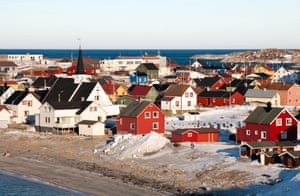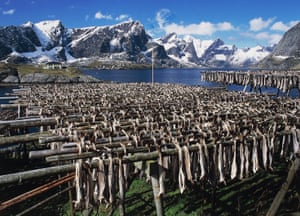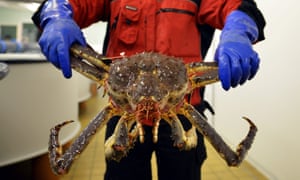The Norwegian fishing village of Bugøynes, 310 miles north of the Arctic Circle and a frigid, dark place for much of the year, was on the edge of ruin.
Work was scarce. Years of overfishing and mismanagement had stymied cod quotas. Boats lay idle in cold waters. Those who chose to stay were forced to rely on what meagre wages they could still muster from fishing and processing.
That is, until the crabs arrived. Starting in the 1980s, woeful fishermen began hoisting up mysterious, spindly giants in their nets in Varangerfjord. The aliens, brandishing two menacing pincers, weighed far more than the brown crabs they had seen farther south.

Unknown to the fishermen, the crustaceans had traveled from Russia, where scientists had introduced red king crabs on the Murman coast during the 1960s with the goal of establishing a new, lucrative fishery. Slowly, the crabs scuttled the 60 or so miles over the border into Norway. The deep fjords in the Barents Sea near Bugøynes provided the perfect cover.
The invasion of “Stalin’s red army” was initially seen as a disaster. The crabs became entangled in gillnets and longlines, removing bait and causing damage that allowed coveted fish species to escape. But when the fishermen learned of the million-dollar Alaskan king crab fishery, they realised the crab could be more boom than bust. Today the red king crab is largely credited with rescuing the fishing villages of the north during a time when cod was sparse.
The monstrous crabs, which now number in the millions, have become the centre of a huge industry: this October alone, Norway exported nearly $9m (£6.7m) worth of king crab. The price of king crab has tripled in just over a decade, according to the Norwegian Seafood Council. The fishermen of Bugøynes can sell their catch for more than 210 Norwegian kroner ($24) a kilo to producers, who distribute the crustaceans to the world’s finest restaurants, hotels and casinos.
The Norwegian government recently announced it was increasing the male crab quota by 18% to 1,810 tonnes in 2021.
But while the crabs have largely been good news for fishermen and the economy, the same can’t be said for other species. Following the crab’s cross-border move, native seafloor species have rapidly declined. The crabs are continuing to expand their territory, and could soon arrive in the Lofoten Islands, one of the world’s largest seasonal cod fisheries.

That puts government regulators in a tough spot, between securing the long-term economic viability of the crab fishery and limiting its takeover of native species and traditional fisheries. They ultimately can’t push for total eradication if king crab is to continue buoying northern coastal communities – but at what cost?
Bonanza comes with a catch
Inside the Norway King Crab facility on the docks of Bugøynes, 3,000 red king crabs float in 30 giant round tanks. This is just one day’s catch. Soon they’ll be transported 1,100 miles by truck to Oslo, where they will be loaded on to cargo planes and shipped live around the world – to Dubai, Los Angeles, Kuala Lumpur.
The fishermen of Varangerfjord place pots year-round, with peak season running from October to January. How many crabs they can catch is regulated by a quota set by the government each year to ensure the future of the commercial fishery. Every few days, fishermen check herring- and mackerel-baited pots that can trap up to 50 large crabs at a time. Then they return to shore to sell their catch.

“When the crabs came here, it put life in our small places,” says Gentjan Kryeziu, operations manager of Norway King Crab, one of the largest crab producers in Troms og Finnmark county. The company buys roughly 20% of the annual quota from fishermen for processing. Kryeziu, originally from Albania, is one of many foreign workers who have moved to Bugøynes to work in the king crab industry.
“If you’re a skilful, not lazy fisherman, you can get your full quota – two or three tonnes per boat – in two or three weeks maximum. Then you are done and get cash in your pocket,” says Roman Vasilyev, a Russian scientist who moved to Bugøynes in 2013 to help advance the technology for shipping live crabs, which sell for more money than processed ones – as much as 1,000 Norwegian kroner ($120) in restaurants.
The king crab earned its spot at the top of the marine monarchy for a reason: it crawls along the seafloor eating starfish, worms, sea cucumbers and molluscs. The crabs have few natural predators in cold Arctic waters.
When researchers surveyed the fjords of the Varanger region around Bugøynes in 2012, they found that the abundance of many seafloor species had dramatically declined since the crab’s arrival. In some areas, mussels and starfish had disappeared completely. Such changes ripple up the food chain: other native species, such as haddock, depend on these seafloor species for food.
“[The crabs] could even change the oxygen conditions on the seafloor since they nip out the animals that dig up and turn over the sediment,” says Haakon Hop, a marine biologist at the Norwegian Polar Institute. A reduction in oxygen, known as hypoxia, can further trigger species die-offs in the marine ecosystem.
These environmental changes have perhaps prompted higher red king crab fishery quotas to help conserve the native bottom-dwellers.
“Over the last few years, the department of fisheries has decided on quotas higher than the recommendations,” says Ton-Ola Rudi, a senior adviser who is responsible for management of king crab in the north.

The government has often dithered over whether to manage the crabs as a valuable fishery stock – setting the total allowable catch to ensure long-term sustainable harvesting – or as a destructive invader, with populations restricted to save other fisheries and species.
In fact, there is already an “eradication” fishery established west of North Cape, about 100 miles from Bugøynes: anyone with a boat here is allowed to harvest king crab. The aim is to prevent the crabs from disrupting another lucrative industry: cod, which gather in abundance at the nearby Lofoten Islands. But around Varangerfjord, where crab density is extremely high, total eradication probably isn’t feasible. Moreover, fishermen can often make more money in less time catching crabs compared with other species and have grown accustomed to the financial rewards.
A budding tourist industry is developing too. Edgar Olsen, who has lived in the town of Nesseby between Varangerfjord and the Tana River all his life, considers himself a fisherman of cod and haddock, but now also fills his crab quota, and works as a tourist guide on king crab expeditions in the fjords, taking visitors out into the fjord to see and, later, taste the crab.

King crab, he says, has had a positive effect for some, but he’d be happier without them, particularly given that cod stocks have recovered in Norway. “It’s quick money,” he says of king crab. But people will lose their whole fish catch if a crab damages the gillnet or long line, he adds.
For now, however, hundreds of small vessels continue to rove the fjords looking for the crustaceans. In parts of northern Norway, gillnet fishing has more or less stopped due to the crustacean’s takeover.
As for its detrimental impact on the ecosystem, the problem is likely to persist as long as king crab retains its popularity on the plate over Norway’s native fish species. “The best parties always have king crab,” says Hop, the marine biologist. “At the confirmation for our daughter, we served king crab. We did not serve cod.”

December 20, 2020 at 04:00PM
https://ift.tt/3ap83Cp
Crab-22: how Norway's fisheries got rich – but on an invasive species - The Guardian
https://ift.tt/2MkGRbk
Crab

No comments:
Post a Comment